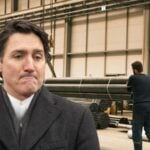Ottawa put a confident face on a difficult trade moment, casting Canada as Washington’s most aligned economic partner while conceding it still needs to chip away at U.S. tariffs that have dogged key industries.
The message came as Prime Minister Mark Carney met President Donald Trump in Washington on Tuesday, seeking momentum toward sector-by-sector relief rather than an immediate, sweeping deal.
Dominic LeBlanc, the minister in charge of Canada-U.S. trade, told lawmakers that “Canada is currently in the best position of any major trading ally of the United States,” while adding that “we have work to do on sectoral tariffs.”
His remarks in the House of Commons framed Ottawa’s strategy as pragmatic and incremental, not a single grand bargain. LeBlanc later told reporters that the talks had generated “momentum,” but that negotiations were far from finished.
The political choreography underscores the stakes for both economies. Related analysis in Canada Heartland Faces New Tariffs as Uncertainty Grows Over Next Year US Trade Deal explores how regional industries are preparing for potential disruptions.
Canada sends roughly three quarters of its goods exports to the United States, and the tariff drag has been most acute in steel, aluminum, autos, and softwood lumber.
Those sectors sit at the center of high-value supply chains that span the border, from mills and smelters in Quebec and British Columbia to auto plants in Ontario and the industrial Midwest.
Any calibrated easing would ripple quickly through employment, prices, and investment planning on both sides.
Canada’s international merchandise trade deficit widened sharply in August to 6.3 billion Canadian dollars, with exports down 3 percent and imports up 0.9 percent, according to a Statistics Canada release on Tuesday.
The agency cited declines in metal and machinery shipments among the drivers.
While one month does not make a trend, the deterioration adds urgency to Ottawa’s bid to de-risk exposed sectors before the scheduled 2026 review of the U.S.-Mexico-Canada Agreement.
Officials have leaned into a sectoral path that starts with the politically sensitive metals complex.
LeBlanc said the goal is to structure arrangements that advance both countries’ economic and security interests, which could include carve-outs, quota-rate thresholds, or joint enforcement against transshipment.
Autos are the other top priority, given their outsized weight in cross-border manufacturing and the risk that lingering uncertainty delays factory investment decisions for the next model cycle.
Despite the tough backdrop, Ottawa argues Canada remains the most reliable U.S. partner because of tightly integrated supply chains, aligned defense and energy interests, and a domestic policy pivot meant to cool flashpoints.
In late summer, the government moved to drop many retaliatory measures against U.S. goods while keeping counter-tariffs on steel, aluminum, and automobiles.
That step was designed to lower the political temperature and refocus talks on items where both sides can claim wins.
The Canadian dollar recently softened on wider-than-expected trade data and a cautious read-through from Washington.
Equity moves have been most visible in tariff-exposed names and transport, while Canadian bond yields have drifted lower in sympathy with Treasuries.
Sectoral tariffs raise input costs, pinch margins, and can slow hiring. The longer they persist, the greater the risk that production footprints shift to avoid uncertainty, even if headline rates eventually fall.
That is why Ottawa is signaling it will take incremental progress rather than hold out for a perfect, all-encompassing pact.
With little chance of an immediate tariff truce, both governments are testing the proposition that trust built in narrower deals can de-risk the hardest files later.
If steel and aluminum find a landing zone, autos and softwood lumber become the next test. The politics are unforgiving, but the economics favor a climbdown.
For now, Canada’s pitch is simple: closest ally, yes, and still plenty of work to do.




















